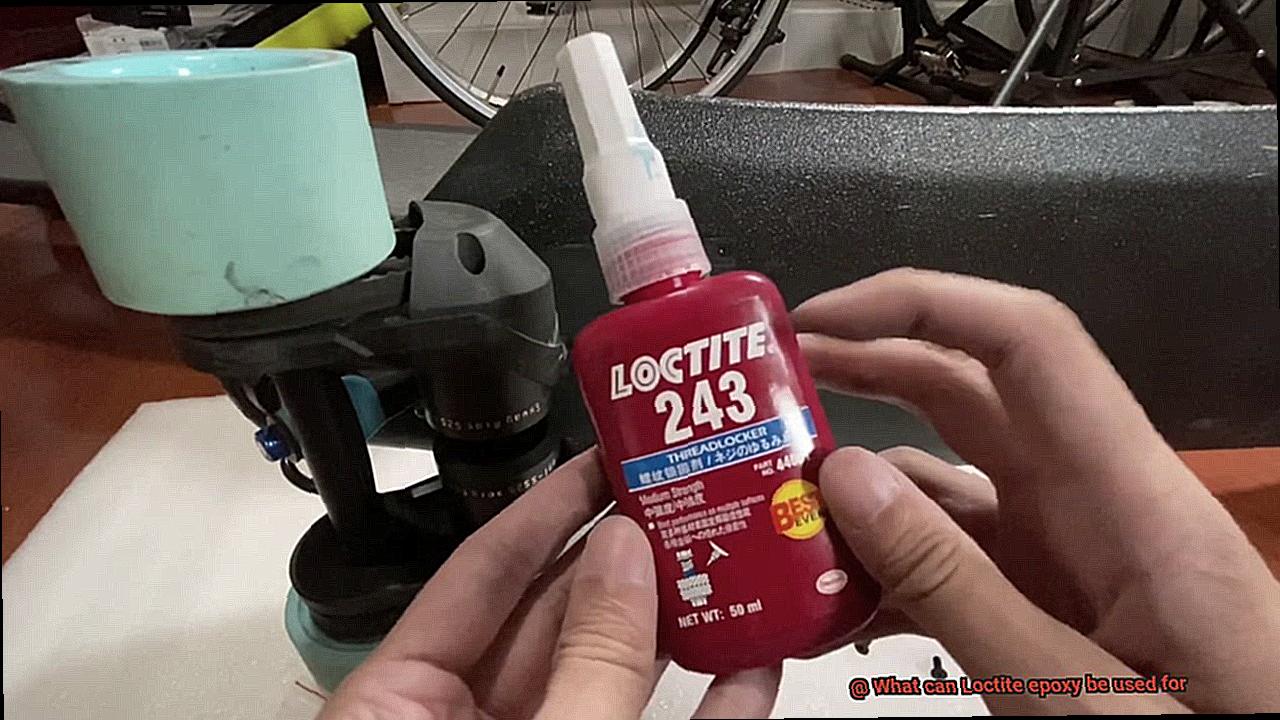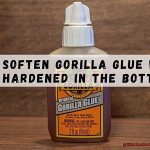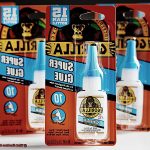As a DIY enthusiast, you know that having a trusty adhesive on hand is essential. And when it comes to adhesives, Loctite epoxy is a fan favorite. But why do so many DIYers swear by this product, and what can it be used for?
First off, let’s talk about strength. Loctite epoxy can bond almost any two surfaces together – metal, wood, ceramics, plastics – you name it. And once it dries, it’s tough as nails. It can withstand heat, chemicals, and physical stress with ease.

But what really sets Loctite epoxy apart is its versatility. Need to repair a broken ceramic? No problem. Want to secure bolts or screws? Easy peasy. Got some gaps that need filling? Loctite epoxy has got your back.
And the best part? It’s super simple to use. Just follow the clear instructions and mix the components together. The drying time is quick too, so you won’t be waiting around for ages before getting back to your project.
So if you’re looking for an adhesive that can handle anything you throw at it (figuratively speaking), give Loctite epoxy a try. You might just be pleasantly surprised by its strength and versatility.
Bonding Capabilities: Adhering Metal, Plastic and Wood Materials
Contents
- 1 Bonding Capabilities: Adhering Metal, Plastic and Wood Materials
- 2 Filling Gaps and Holes: Providing a Smooth Finish
- 3 Protective Coating and Sealant: Prevent Corrosion, Moisture and Chemicals
- 4 Crafting and DIY Projects: Creating Jewelry, Sculptures and Decorative Items
- 5 Industrial Applications: Pipelines, Tanks and Machinery
- 6 Benefits of Loctite Epoxy: Strength, Durability and Versatility
- 7 Tips for Using Loctite Epoxy: Preparation, Mixing and Application
- 8 Common Mistakes to Avoid When Using Loctite Epoxy
- 9 Conclusion
If you’re tired of using different adhesives for different materials, Loctite epoxy is the answer. This multi-purpose adhesive is a top choice for bonding metal, plastic, and wood materials with ease. The secret to its success lies in its exceptional strength and durability.
When mixed together, the epoxy resin and hardener create a bond that can withstand high stresses and temperatures. This makes it ideal for use in industrial and automotive applications where harsh environmental conditions are a constant challenge.
For metal materials, Loctite epoxy can bond different types of metals together, such as aluminum, brass, copper, and stainless steel. It can also bond metal to other materials such as plastic and wood. Its versatility makes it an excellent choice for use in automotive applications.
When it comes to plastic materials, Loctite epoxy can bond various types of plastics such as PVC, ABS, polycarbonate, and acrylics. Its ability to resist impact and vibration makes it perfect for use in electronics and automotive applications.
For wood materials, Loctite epoxy can bond different types of wood together, such as hardwoods and softwoods. It can also bond wood to other materials such as metal and plastic. Its ability to withstand weathering and moisture exposure makes it the perfect choice for outdoor applications such as furniture and decking.
But wait, there’s more. Loctite epoxy can also be used as a coating or sealant. It provides protection against corrosion, moisture, and chemicals. This makes it an ideal solution for industrial applications such as pipelines, tanks, and machinery.
Whether you’re a professional or a DIY enthusiast, Loctite epoxy is a versatile adhesive that will make your life easier. With its exceptional bonding capabilities and durability, you can trust that your projects will stand the test of time. Just remember to follow the recommended surface preparation guidelines and application instructions for the best results.
Filling Gaps and Holes: Providing a Smooth Finish
Loctite epoxy is your superhero adhesive for filling in even the largest gaps and holes while providing a smooth and seamless finish.
Before applying Loctite epoxy, it’s crucial to prep the surface properly by thoroughly cleaning it with a degreaser or solvent cleaner. Once the surface is prepped, mix the two-part epoxy according to the instructions provided on the packaging.
For small gaps or holes, apply the mixed epoxy with a toothpick or small brush. For bigger ones, use a putty knife to spread the epoxy evenly over the surface. Remember to apply it smoothly and evenly for a seamless finish.
After applying Loctite epoxy, let it cure completely before sanding or painting. This ensures a strong and durable bond. Once cured, you can sand down the epoxy to provide an extra-smooth finish that blends in seamlessly with the surrounding surface.
Loctite epoxy is versatile and can fill gaps and holes in various materials such as metal, wood, ceramics, and plastics. Its two-part system creates a durable bond that fills in even large gaps or holes.
Protective Coating and Sealant: Prevent Corrosion, Moisture and Chemicals
Loctite epoxy is here to save the day as the ultimate protective coating and sealant.
Not only is Loctite epoxy a versatile adhesive that can bond to a variety of surfaces, including metal, plastic, glass, and ceramics, but it also creates a strong and durable barrier that can withstand even the harshest of environments.
One of the primary advantages of using Loctite epoxy is its resistance to corrosion. If your equipment is exposed to moisture or chemicals, this powerful adhesive can create a protective barrier between the metal surface and the surrounding environment. This helps to prolong the lifespan of your equipment and prevent costly repairs.
Furthermore, Loctite epoxy creates a waterproof barrier that stops moisture from penetrating the surface of your equipment. Corrosion caused by rust and other forms of damage can weaken the structure over time. But with Loctite epoxy, you can rest easy knowing that your equipment is protected from moisture damage.
Finally, Loctite epoxy is resistant to a wide range of chemicals and solvents. This makes it an excellent choice for applications where surfaces are exposed to harsh chemicals that could cause significant damage. With Loctite epoxy, you can prevent chemical contact with surfaces and extend the life of your equipment.
Crafting and DIY Projects: Creating Jewelry, Sculptures and Decorative Items
Look no further than Loctite epoxy. This superhero adhesive is a must-have in any crafting toolbox. As an expert in crafting and DIY projects, I can attest to the versatility and reliability of this powerful adhesive.
Loctite epoxy is ideal for creating jewelry pieces that require a secure attachment of beads, stones, and other embellishments. Its ability to bond almost any surface together makes it a great choice for working with metal, plastic, wood, or even glass. With Loctite epoxy, you can create a strong and durable bond that will stand the test of time.
But Loctite epoxy isn’t just limited to jewelry making. It’s also perfect for creating sculptures and decorative items. Its ability to fill gaps and cracks helps to create a smooth and seamless finish that is essential for achieving a professional look. Whether you’re working with metal and wood or different materials altogether, Loctite epoxy can help you bond them together seamlessly.
Using Loctite epoxy for crafting and DIY projects is simple, but it’s important to follow the manufacturer’s instructions carefully. Mixing equal parts of the resin and hardener together until they are completely blended is key to achieving a strong bond. Once applied, the adhesive should be left to cure completely before handling or moving your project.
Industrial Applications: Pipelines, Tanks and Machinery
This versatile adhesive is a superhero in the world of pipelines, tanks, and machinery.
When it comes to pipelines, Loctite epoxy is a game-changer. In the oil and gas industry, pipelines are used to transport large volumes of liquids and gases over long distances. Failure or leaks can be costly and dangerous.
Loctite epoxy can be used to repair leaks or bond new pipes together, providing a reliable solution that can withstand the harsh conditions of this industry. Plus, it’s easy to apply, which means less downtime for your operation.
But Loctite epoxy’s usefulness doesn’t stop with pipelines. It’s also an ideal adhesive for sealing and repairing tanks. This adhesive can seal cracks or holes in storage tanks that hold chemicals or other corrosive substances, preventing leaks and ensuring that the chemicals stay where they belong.
Additionally, it can be used to bond tank components together, so you can rest assured that everything stays securely attached under high-stress conditions.
Finally, Loctite epoxy is commonly used in the maintenance and repair of machinery. Its high-strength and durability make it perfect for bonding metal components together or filling gaps and holes in machinery parts.
Whether you’re dealing with heavy machinery subject to high stresses and vibrations or smaller equipment that needs a reliable adhesive, Loctite epoxy has got you covered.
Benefits of Loctite Epoxy: Strength, Durability and Versatility
Look no further than Loctite Epoxy – the ultimate two-part adhesive system that offers exceptional strength, durability, and versatility. As an expert in the field, I can attest to the many benefits of this adhesive solution that make it a popular choice among professionals and DIY enthusiasts alike.
One of the primary benefits of Loctite Epoxy is its strength. This superhero adhesive creates a permanent and high-strength bond that can withstand heavy loads and extreme temperatures. From automotive repairs to construction projects and industrial applications, this adhesive solution provides a reliable and long-lasting bond that will keep your projects intact for years to come.
But the benefits of Loctite Epoxy don’t stop there. It’s also incredibly durable, making it suitable for outdoor applications. Its resistance to water, chemicals, and UV radiation combined with excellent impact resistance means that it can withstand rough handling without cracking or breaking. That’s durability you can count on.

The versatility of Loctite Epoxy is another standout feature that makes it an ideal adhesive solution for a wide range of projects. It can bond different materials, including metal, wood, plastic, ceramic, and glass. Whether you’re repairing household items or building custom furniture, this adhesive solution can provide a reliable and long-lasting bond.
Tips for Using Loctite Epoxy: Preparation, Mixing and Application
Loctite epoxy is a reliable adhesive that can be used for a wide range of applications, but proper preparation, mixing, and application are key to ensuring that the bond is strong and long-lasting. Here are some important tips to help you achieve the best results.
Preparation:
Before applying Loctite epoxy, it is essential to prepare the surfaces that will be bonded. Clean the surfaces thoroughly and ensure that they are free from any dirt, dust, grease, or oil. Use sandpaper or a wire brush to roughen up the surfaces slightly for better adhesion.
If necessary, clean the surfaces with alcohol or acetone. Having all the necessary tools and materials on hand before starting the project will also make the process smoother and save you time in the long run.
Mixing:
Mixing the two parts of Loctite epoxy (resin and hardener) is an important step in achieving a strong bond. Follow the instructions provided by the manufacturer closely, and use a disposable mixing container and stir stick to ensure that the epoxy cures properly and achieves maximum strength. Mix the two parts of the epoxy together thoroughly for at least one minute.
Application:
The application of Loctite epoxy should be done carefully in a well-ventilated area. Wear protective gloves to avoid skin contact. Apply the epoxy evenly to the surface using a brush or spatula, ensuring that there are no air bubbles and that the epoxy is spread evenly over the surface. Avoid moving or disturbing your project during this time as it may affect the bond strength of the epoxy.
Curing:
Once applied, allow Loctite epoxy to cure according to the manufacturer’s instructions. The curing time may vary depending on factors such as temperature and humidity. It is important not to disturb or move your project during this time, as it may affect the bond strength of the epoxy.
Common Mistakes to Avoid When Using Loctite Epoxy
Loctite epoxy is a remarkable adhesive that can bond almost any material together, from metals and plastics to ceramics and wood. However, to achieve a strong and long-lasting bond, it’s important to avoid common mistakes that people make when using Loctite epoxy.
The first mistake people make is not properly preparing the surfaces to be glued. It’s crucial to clean and dry both surfaces thoroughly before applying the epoxy. Any dirt, grease, or moisture can prevent the epoxy from bonding effectively.
Another mistake is using too much or too little epoxy. It’s vital to follow the instructions carefully and apply the right amount of epoxy for the job. Using too much glue can lead to an unpleasant and messy situation, while using too little can create a weak bond that won’t last.
Mixing the two components of the epoxy thoroughly enough is also essential. The resin and hardener must be mixed together until they are completely blended, with no streaks remaining. Failing to do this can result in a weak bond that may not hold up over time.
Additionally, make sure to use the right type of Loctite epoxy for the job. Different formulas are available for different materials and applications. Using the wrong type of epoxy can cause damage or create a weak bond. It’s always best to read the label and ensure that you have selected the correct one.
Lastly, be patient and give the epoxy enough time to cure before handling the glued objects. Rushing the process can result in a weak bond that won’t hold up over time. It’s essential to wait until the curing process is complete, which varies depending on the type of Loctite epoxy used.
vYZCoMd6CCo” >
Conclusion
In summary, Loctite epoxy is a jack-of-all-trades adhesive that can tackle a wide variety of tasks. Its unparalleled strength, resilience, and versatility have made it a favorite among professionals and DIY enthusiasts alike. This adhesive can securely bind nearly any two surfaces together, from metal and plastic to wood, ceramics, and glass. It can also fill gaps and holes for a smooth finish or act as a protective coating and sealant to prevent corrosion, moisture damage, and chemical contact.
To make the most out of Loctite epoxy’s capabilities, proper preparation, mixing, and application are crucial. Clean surfaces are essential before applying the adhesive solution; mixing the two parts until they’re fully blended is also important.
Applying the epoxy evenly ensures there are no air bubbles or unevenness in the bond. Common mistakes like using too much or too little adhesive or not allowing enough time for curing should be avoided.
Whether you’re working on crafting projects or industrial applications such as pipelines, tanks, and machinery repairs – Loctite epoxy has got your back with its exceptional bonding capabilities and durability.






